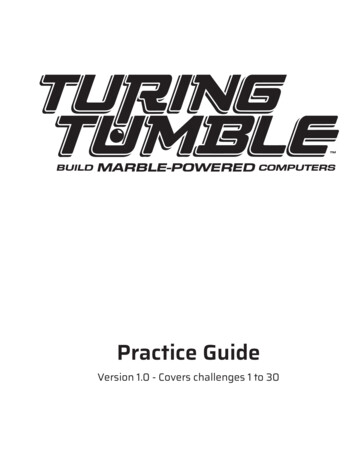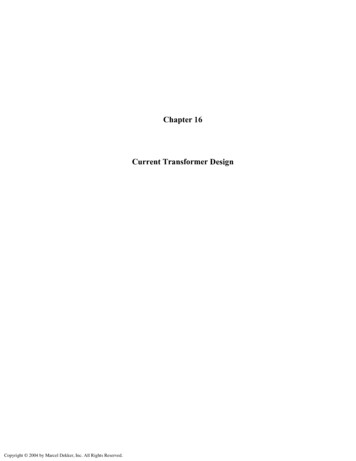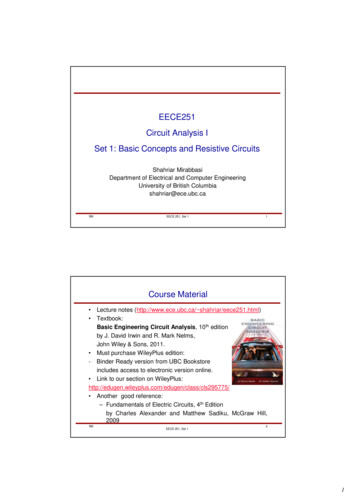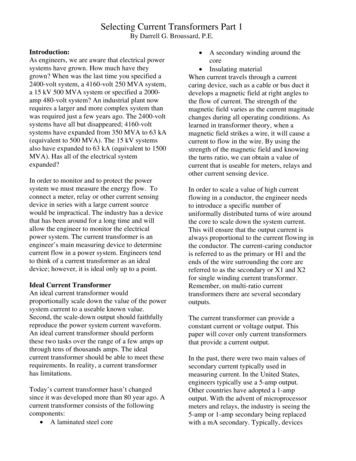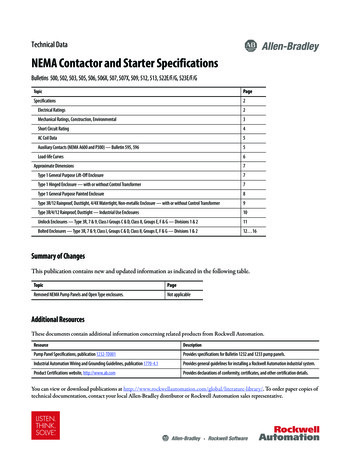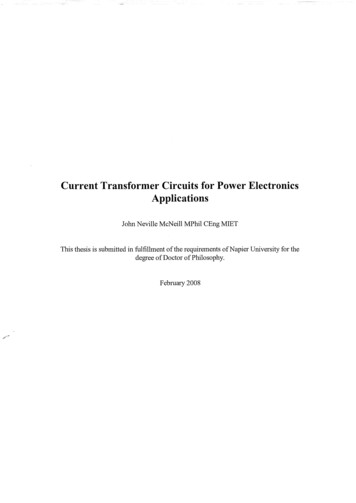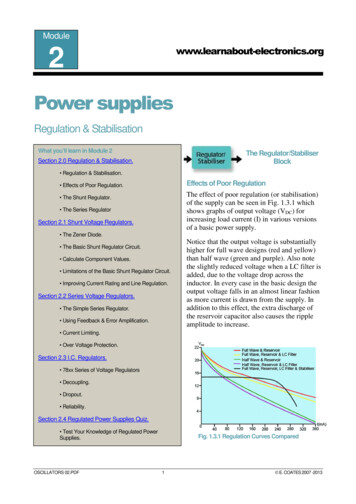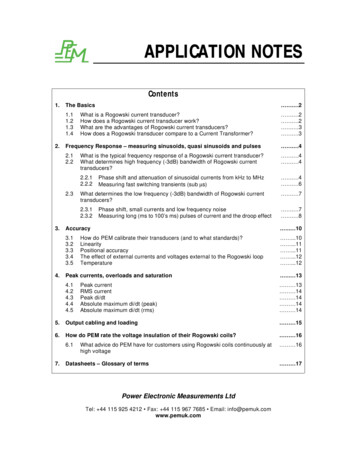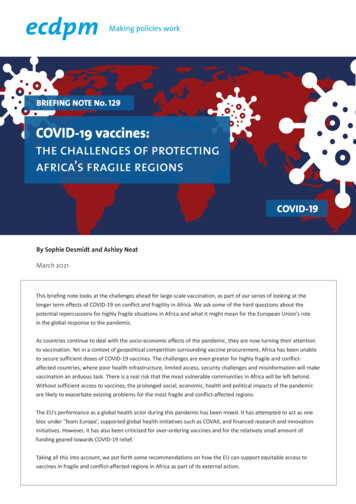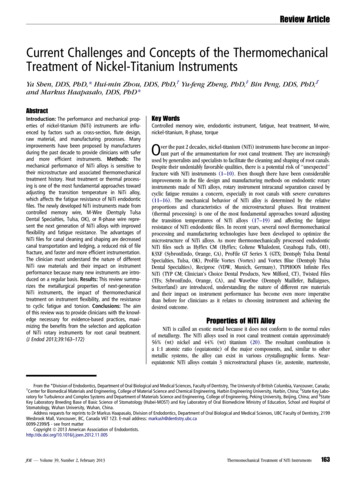
Transcription
Review ArticleCurrent Challenges and Concepts of the ThermomechanicalTreatment of Nickel-Titanium InstrumentsYa Shen, DDS, PhD,* Hui-min Zhou, DDS, PhD,† Yu-feng Zheng, PhD,‡ Bin Peng, DDS, PhD,§and Markus Haapasalo, DDS, PhD*AbstractIntroduction: The performance and mechanical properties of nickel-titanium (NiTi) instruments are influenced by factors such as cross-section, flute design,raw material, and manufacturing processes. Manyimprovements have been proposed by manufacturersduring the past decade to provide clinicians with saferand more efficient instruments. Methods: Themechanical performance of NiTi alloys is sensitive totheir microstructure and associated thermomechanicaltreatment history. Heat treatment or thermal processing is one of the most fundamental approaches towardadjusting the transition temperature in NiTi alloy,which affects the fatigue resistance of NiTi endodonticfiles. The newly developed NiTi instruments made fromcontrolled memory wire, M-Wire (Dentsply TulsaDental Specialties, Tulsa, OK), or R-phase wire represent the next generation of NiTi alloys with improvedflexibility and fatigue resistance. The advantages ofNiTi files for canal cleaning and shaping are decreasedcanal transportation and ledging, a reduced risk of filefracture, and faster and more efficient instrumentation.The clinician must understand the nature of differentNiTi raw materials and their impact on instrumentperformance because many new instruments are introduced on a regular basis. Results: This review summarizes the metallurgical properties of next-generationNiTi instruments, the impact of thermomechanicaltreatment on instrument flexibility, and the resistanceto cyclic fatigue and torsion. Conclusions: The aimof this review was to provide clinicians with the knowledge necessary for evidence-based practices, maximizing the benefits from the selection and applicationof NiTi rotary instruments for root canal treatment.(J Endod 2013;39:163–172)Key WordsControlled memory wire, endodontic instrument, fatigue, heat treatment, M-wire,nickel-titanium, R-phase, torqueOver the past 2 decades, nickel-titanium (NiTi) instruments have become an important part of the armamentarium for root canal treatment. They are increasinglyused by generalists and specialists to facilitate the cleaning and shaping of root canals.Despite their undeniably favorable qualities, there is a potential risk of ‘‘unexpected’’fracture with NiTi instruments (1–10). Even though there have been considerableimprovements in the file design and manufacturing methods on endodontic rotaryinstruments made of NiTi alloys, rotary instrument intracanal separation caused bycyclic fatigue remains a concern, especially in root canals with severe curvatures(11–16). The mechanical behavior of NiTi alloy is determined by the relativeproportions and characteristics of the microstructural phases. Heat treatment(thermal processing) is one of the most fundamental approaches toward adjustingthe transition temperatures of NiTi alloys (17–19) and affecting the fatigueresistance of NiTi endodontic files. In recent years, several novel thermomechanicalprocessing and manufacturing technologies have been developed to optimize themicrostructure of NiTi alloys. As more thermomechanically processed endodonticNiTi files such as HyFlex CM (HyFlex; Coltene Whaledent, Cuyahoga Falls, OH),K3XF (SybronEndo, Orange, CA), ProFile GT Series X (GTX; Dentsply Tulsa DentalSpecialties, Tulsa, OK), ProFile Vortex (Vortex) and Vortex Blue (Dentsply TulsaDental Specialties), Reciproc (VDW, Munich, Germany), TYPHOON Infinite FlexNiTi (TYP CM; Clinician’s Choice Dental Products, New Milford, CT), Twisted Files(TFs; SybronEndo, Orange, CA), and WaveOne (Dentsply Maillefer, Ballaigues,Switzerland) are introduced, understanding the nature of different raw materialsand their impact on instrument performance has become even more imperativethan before for clinicians as it relates to choosing instrument and achieving thedesired outcome.Properties of NiTi AlloyNiTi is called an exotic metal because it does not conform to the normal rulesof metallurgy. The NiTi alloys used in root canal treatment contain approximately56% (wt) nickel and 44% (wt) titanium (20). The resultant combination isa 1:1 atomic ratio (equiatomic) of the major components, and, similar to othermetallic systems, the alloy can exist in various crystallographic forms. Nearequiatomic NiTi alloys contain 3 microstructural phases (ie, austenite, martensite,From the *Division of Endodontics, Department of Oral Biological and Medical Sciences, Faculty of Dentistry, The University of British Columbia, Vancouver, Canada;Center for Biomedical Materials and Engineering, College of Material Science and Chemical Engineering, Harbin Engineering University, Harbin, China; ‡State Key Laboratory for Turbulence and Complex Systems and Department of Materials Science and Engineering, College of Engineering, Peking University, Beijing, China; and §StateKey Laboratory Breeding Base of Basic Science of Stomatology (Hubei-MOST) and Key Laboratory of Oral Biomedicine Ministry of Education, School and Hospital ofStomatology, Wuhan University, Wuhan, China.Address requests for reprints to Dr Markus Haapasalo, Division of Endodontics, Department of Oral Biological and Medical Sciences, UBC Faculty of Dentistry, 2199Wesbrook Mall, Vancouver, BC, Canada V6T 1Z3. E-mail address: markush@dentistry.ubc.ca0099-2399/ - see front matterCopyright ª 2013 American Association of .11.005†JOE — Volume 39, Number 2, February 2013Thermomechanical Treatment of NiTi Instruments163
Review Articleand R-phase), the character and relative proportions of which determine the mechanical properties of the metal (21). NiTi alloy hasspecial characteristics of superelasticity and shape memory. Becauseit is a superelastic (SE) metal, the application of stress does notresult in the usual proportional strain seen in stainless steel. Thesuperelasticity of NiTi allows deformations of as much as 8% strainto be recoverable in comparison with a maximum of less than 1%with stainless steel. This unusual property is the result of stressinduced martensite transformation. External stresses transform theaustenitic crystalline form of NiTi into a martensitic crystalline structure that can accommodate greater stress without increasing thestrain. As a result of its unique crystalline structure, a NiTi file hassuperelasticity (ie, the ability to return to its original shape afterbeing deformed). Simply stated, NiTi alloys currently are the onlyreadily available and affordable materials with the flexibility andtoughness for routine use as effective rotary endodontic files incurved canals. Superelasticity occurs in association with a reversiblephase transformation between austenite and martensite. Therefore,the transformation temperatures have a critical influence on themechanical properties and the behavior of NiTi, which can be alteredby small changes in composition, impurities, and heat treatmentsduring the manufacturing process (22). This distinct property ofNiTi alloys has created a revolution in the manufacture of endodonticinstruments.The NiTi shape memory alloy can exist in 2 different temperaturedependent crystal structures (phases) called martensite (low-temperature phase, with a monoclinic B190 structure) and austenite (hightemperature or parent phase, with the B2 cubic crystal structure).Several properties of austenite NiTi and martensite NiTi are notablydifferent (23, 24). When martensite NiTi is heated, it begins tochange into austenite. The temperature at which this phenomenonbegins is called the austenite transformation start temperature (As).The temperature at which this phenomenon is complete is called theaustenite finish temperature (Af), which means that at and above thistemperature the material will have completed its shape memorytransformation and will display its SE characteristics. When austeniteNiTi is cooled, it begins to change into martensite. The temperatureat which this phenomenon begins is called the martensitetransformation start temperature (Ms). The temperature at whichmartensite is again completely reverted is called the martensitetransformation finish temperature (Mf) (23, 24). The Af temperaturefor most conventional SE NiTi files is at or below room temperature,whereas the Af of the new controlled memory (CM) files (TYP) isclearly above body temperature. As a result, the conventional NiTifiles are in the austenite phase during clinical use, whereas CM filesare mainly in the martensite phase (25).Composition and metallurgical treatments have dramaticimpacts on these transition temperatures. From the point of viewof practical applications, NiTi can have 3 different forms: martensite,stress-induced martensite (SE), and austenite. When the material isin its martensite form, it is soft and ductile and can easily bedeformed. SE NiTi is highly elastic, whereas austenitic NiTi is quitestrong and hard (25). The equiatomic NiTi alloy has all these properties, with the specific expression being dependent on the temperature at which it is used.Brantley et al (26) were the first ones in the endodontic literature to show that the structure of the NiTi rotary instruments can beconveniently investigated by differential scanning calorimetry (DSC).They indicated that the Af temperature of conventional NiTi rotaryinstruments (Lightspeed and ProFile) was near 25 C at roomtemperature. Therefore, these instruments would show SE behaviorduring clinical use.164Shen et al.Metallurgical Characterization ofThermomechanically-treated NiTi InstrumentsAt the beginning of 2000, a series of studies (27–30) found thatchanges in the transformation behavior via heat treatment wereeffective in increasing the flexibility of NiTi endodontic instruments.Since then, heat-induced or heat-altering manipulations were used toinfluence or alter the properties of NiTi endodontic instruments, whichwere once cited as the main reasons for pursuing the use of NiTi instruments in endodontics. Proprietary thermomechanical processing isa complicated process that integrates hardening and heat treatmentinto a single process. Alapati et al (31) found that heat treatments at400 C, 500 C, and 600 C raised the Af temperature of ProFile to45 C–50 C, and heat treatment at 850 C caused a loss of SE behaviorand recrystallization of the wrought microstructure. DSC curves werevery complex with irregular peaks. These results were also confirmedby other studies (28, 32). Therefore, the manufacturer must performan appropriate heat treatment, which will be accompanied bybeneficial changes in mechanical properties and improved clinicalperformance.Recently, a different approach has been used to optimize the structure of the NiTi wire blanks for rotary instruments. A series of proprietary thermomechanical processing procedures has been developedwith the objective of producing SE NiTi wire blanks that contain thesubstantially stable martensite phase under clinical conditions.Enhancements in these areas of material management have led to thedevelopment of the next-generation endodontic instruments.M-Wire (Dentsply Tulsa Dental Specialties) was introduced in2007 and is produced by applying a series of heat treatments to NiTiwire blanks. M-Wire instruments include Dentsply’s ProFile GT SeriesX, ProFile Vortex, and Vortex Blue. In 2008, a new manufacturingprocess was also developed by SybronEndo to create a NiTi endodonticinstrument—TFs. According to the manufacturer, TF instruments weredeveloped by transforming a raw NiTi wire in the austenite phase intothe R-phase through a thermal process (product brochure: www.tfwithrphase.com/images/3987 TF Brochure.pdf). The R-phase is anintermediate phase with a rhombohedral structure that can form duringforward transformation from martensite to austenite on heating andreverse transformation from austenite to martensite on cooling. Itoccurs within a very narrow temperature range.CM Wire (DS Dental, Johnson City, TN) is a novel NiTi alloy withflexible properties that was introduced in 2010. CM NiTi files havebeen manufactured using a special thermomechanical process thatcontrols the memory of the material, making the files extremely flexiblebut without the shape memory of other NiTi files, as opposed to whatis found with conventional SE forms of NiTi (product 4A HYFLEX-CM bro.pdf)(33). Both HyFlex and TYP are made from CM Wire.The martensitic phase of NiTi has some unique properties thathave made it an ideal material for many applications (34). The martensitic form of NiTi has remarkable fatigue resistance. Instruments in themartensite phase can easily be deformed, yet they will recover theirshape on heating above the transformation temperatures. The explanation for this may be that heating transforms the metal temporarily intothe austenitic phase and makes it SE, which makes it possible for the fileto regain its original shape before cooling down again. The properties ofthe bulk materials are the main determinant of fatigue life (35–42). CMWire and M-Wire instruments have increased austenite transformationtemperatures. The Af of CM Wire, M-Wire, TF, and conventional SE NiTiwire are approximately 55 C, 50 C, 17 C, and 16 –31 C, respectively(42–45). The conventional SE NiTi file has an austenite structure(26, 42–46), whereas NiTi file with thermal processing (eg, TYP CMJOE — Volume 39, Number 2, February 2013
Review ArticleFigure 1. The tensile stress-strain curves of as-received CM and SE wires witha diameter of 0.64 mm. The test was conducted at room temperature (RT) andoral temperature (37 C).and Vortex) would essentially be in the martensite condition at bodytemperature (42, 44, 45, 47). In addition, the critical stress formartensite reorientation of CM Wires is in the range of 128–251 MPaat room temperature and 37 C, which is much lower than the criticalstress for stress-induced martensite transformation of the SE wires(490–582 MPa) (42). The ultimate tensile strength for the CM Wires(about 1094 MPa) is also lower than that of SE wires (about 1415MPa). However, the maximum strain of CM Wires before fracture(58.4%–84.7%) is much higher than that of the SE wires(16.7%–27.5%) (Fig. 1). These results indicate the superior flexibilityof CM Wire compared with conventional SE NiTi wire.The superelasticity of the NiTi alloy means that it cannot maintaina spiral shape as the alloy undergoes nonpermanent deformation;therefore, a grinding technique was initially used in the manufactureof SE NiTi instruments. Contrary to this, TF is a recently introducedNiTi rotary file manufactured with a twisting method. It is fabricatedby transforming austenite NiTi wire into the R-phase through a thermalprocess. Once the R-phase is identified, wire in this state can be twisted.After additional thermal procedures to maintain its new shape, theinstrument is converted back into the austenite phase, which is SEonce stressed. This proprietary technology was used to optimize thephase constituents and properties of TF NiTi files (48). The 2-step transformation through an apparent R-phase can be observed for TFs in DSCcurves (43, 44).Mechanical Performance ofThermomechanically-treated NiTi InstrumentsTwo mechanisms that may lead to NiTi rotary fracture, namelycyclic fatigue and torsional overloading, have been described (2, 13,49–51). Cyclic fatigue occurs as a result of rotation around a curveby repeated extension and compression of the metal and, finally,work hardening followed by fracture (15, 49). Torsional fractureoccurs when the tip of the rotating instrument binds in the canalwhile the motor continues to rotate (2, 13). Torsional fracture of thematerial occurs when the ultimate strength of the material isexceeded. Thus, an instrument needs to be resistant to cyclic fatigueand have sufficient flexibility to permit the preparation of curvedsystems but also sufficient torque strength so that instrumentseparation does not occur. Fatigue has been implicated as the mainreason for the fracture of endodontic rotary files used clinically (11, 14).JOE — Volume 39, Number 2, February 2013Fatigue PropertiesFor NiTi alloys, the total fatigue life consists of 3 stages: (1)crack initiation, in which microcracks form and start to growpreferentially along specific crystallographic planes or grainboundaries followed by (2) crack propagation, in which the crackgrows continuously, until (3) the crack reaches the point wherethe remaining material is overstressed and the result is theoverload zone results. The overload zone features a typicaldimple rupture or so-called ductile failure (35, 50, 52). Ahybrid (austenite-to-martensite) microstructure with a certainproportion of martensite is more likely to have favorable fatigueresistance than a fully austenitic microstructure (53). This isgenerally explained by the fatigue-crack growth resistance of themartensite, which is found to be superior to that of stableaustenite, particularly near the threshold, by comparing the fatiguebehavior of the various microstructures in nitinol (53). At thesame stress intensity level, the fatigue crack propagation speedof austenitic structures is much faster than that of martensiteones. In addition, the martensitic phase transformation has excellent damping characteristics because of the energy absorptioncharacteristics of its twinned phase structure. Although TFs consistmainly of austenite in the oral environment, the bending loadvalues in elastic and SE ranges were lower for TFs than thoseof conventional SE NiTi files (43). Therefore, the manufacturersclaim that the thermomechanical treatment of NiTi instrumentsyields greater resistance to cyclic fatigue when compared withconventional SE NiTi instruments.To date, there is no specification or international standard totest the cyclic fatigue resistance of endodontic rotary instruments.Four methods (13) have been used to investigate in vitro fatiguefracture resistance of NiTi rotary endodontic instruments: (1)curved metal tube (49), (2) grooved block-and-rod assembly(54–60), (3) rotation against an inclined plane (61, 62), and(4) 3-point bend of a rotating instrument (32, 63, 64).However, in an effort to understand the nature of the metalalterations and their impact on enhancing resistance to fatigue inparticular, an international standard for cyclic fatigue testing ofNiTi rotary instruments should be developed in order to ensurethe uniformity of methodologies so that the resulting data can becompared (15).CM WireInstruments made from CM Wire (TYP CM and DSSS0250425NEYY CM [NEYY CM]) were nearly 300%–800% moreresistant to fatigue failure than instruments made from conventionalNiTi wire with the same design in a dry condition in a 3-pointbending device (39) (Table 1). The square (NEYY CM) configurationof NiTi instruments made from CM Wire showed a significantly longerfatigue life than the triangular configuration (TYP CM). Therefore,the design of the instrument should also be taken into accountbecause it is an important determinant of the fatigue lifetime. Fractographically, a single-crack origin is usually found in conventionalNiTi wire files. CM Wire instruments had a higher number ofmultiple-crack origins than conventional NiTi wire files of thesame design, especially NEYY CM instruments (92% files withmultiple-crack origins). Nearly all of the specimens showed fatiguecrack initiation at 1 or more cutting edges of the fracture crosssection unless a subsurface void or inclusion was present elsewhere(39). The values of the fracture area occupied by the dimple region(showing the final fracture) were significantly smaller on NiTi instruments made from CM Wire than on instruments made fromThermomechanical Treatment of NiTi Instruments165
Review ArticleTABLE 1. A List of Literature on the Mechanical Properties of Thermomechanically Treated NiTi Instruments with Continuous RotationPhase transformationCM Wire (HyFlexCM, TYPHOONInfinite Flex NiTi)M-Wire (ProFile GTSeries X, ProFileVortex, VortexBlue)R-phase wire(K3XF, TFs)Flexible propertyCyclic fatigueShen et al, 2011 (44)Testarelli et al, 2011 (105);Zhou et al, 2012 (42)Alapati et al, 2009 (47);Shen et al, 2011 (44);Ye and Gao, 2012 (45)Gao et al, 2012 (41)Hou et al, 2011 (43);Shen et al, 2011 (44)Gambarini et al, 2008 (48);Hou et al, 2011 (43)Shen et al, 2011 (39);Shen et al, 2012 (40);Peters et al, 2012 (92)Gambarini et al, 2008 (66);Johnson et al, 2008 (68);Larsen et al, 2009 (69);Kramkowski and Bahcall,2009 (90);Gao et al, 2010 (38);Al-Hadlaq et al, 2010 (67);Hilfer et al, 2011 (84);Gao et al, 2012 (41);Plotino et al, 2012 (86)Gambarini et al, 2008 (66);Larsen et al, 2009 (69);Kim et al, 2010 (70);Bhagabati et al, 2011 (71)Rodrigues et al, 2011 (72); et al, 2011 (73);PedullaHilfer et al, 2011 (84)conventional NiTi wire (Fig. 2A–D). Hence, it is not surprising thatCM series files had fatigue resistance superior to that of files madefrom conventional NiTi alloy.Endodontic instruments are used to prepare the root canal inthe presence of an irrigating solution. A recent study (40) showedthat 2 CM Wire instruments (ie, TYP CM and NEYY CM) yieldeda 4–9 times longer fatigue life than conventional NiTi files with thesame design under various solutions. The fatigue life of 3 conventional SE NiTi instruments was unaffected by the environments,whereas the fatigue life of the 2 CM file types was much longer inliquid media than in air. This may imply that the fatigue of NiTi alloysis sensitive to temperature, both locally and environmentally. A function of the aqueous media in metal fatigue behavior is to carry theheat away from the metal-to-metal contact. Therefore, an aqueousTorsional fractureCasper et al, 2011 (95);Peters et al, 2012 (92)Johnson et al, 2008 (68);Kramkowski and Bahcall,2009 (90);Casper et al, 2011 (95);Bardsley et al, 2011 (100);King et al, 2012 (96);Gao et al, 2012 (41)Gambarini et al, 2009 (98);Park et al, 2010 (93);Gambarini et al, 2010 (97);Casper et al, 2011 (95);King et al, 2012 (96)medium seems to serve as an effective heat sink to facilitate thelong fatigue life of the CM instrument.M-WireA few years ago, a modification of the SE508 NiTi alloy used forendodontic instruments was developed (65) by Dentsply (M-Wire).Several studies have examined the fatigue resistance of M-Wire NiTi files(38, 41, 66–68). However, the results from these studies cannot easilybe compared with one another because of variations in theexperimental design and testing model.A major drawback of most laboratory testing of the fatiguebehavior of NiTi rotary instruments is the inability to eliminate severalconfounding factors, such as material properties, design, andFigure 2. Photomicrographs of a fracture surface of TYP files with the region of fatigue crack propagation and dimple area outlined (dotted line) with crackorigins (arrows). (A) The overall view of the TYP file (Nf 315, dimple area is 69%). (B) A high-magnification view of the crack origin (arrow). (C) An overallview of the TYP CM file with 2 crack origins (arrows) (Nf 1280, dimple area is 36%). (D) A high-magnification view of 1 crack origin (arrow).166Shen et al.JOE — Volume 39, Number 2, February 2013
Review Articledimensions of the instrument, which are specific to the brand(s) beingtested. This has made it difficult to quantify the effect of a single variableon fatigue behavior. It is important to evaluate the influence of raw materials on the fatigue and mechanical properties by using a similar filedesign. Johnson et al (68) reported that instruments made fromM-Wire with a ProFile design exhibited nearly 400% more resistanceto cyclic fatigue than SE wire instruments of the same size. Gao et al(38) compared the cyclic fatigue resistance of ProFile Vortex rotaryinstruments made of 2 different raw materials: M-Wire and regularSE wire at 2 different rotational speeds. ProFile Vortex files madefrom M-Wire exhibited superior cyclic fatigue resistance (150% longerfatigue life) compared with those made from regular SE wire at 2 testspeeds (ie, 300 and 500 rpm). There was no significant difference infatigue resistance under different rotational speeds of 300 and 500rpm. The fatigue life of M-Wire in this study is different from that reported by Johnson et al (68). This can partially be explained by thefact that the file design of the traditional ProFile files is considerablydifferent from that of new ProFile Vortex files (triangular crosssection without noncutting radial land).Recently, Gao et al (41) evaluated the impact of raw materials(including stainless steel, conventional SE NiTi, M-Wire NiTi, and VortexBlue NiTi) on the fatigue resistance of rotary instruments (25/.06) byrotating the files in an artificially constructed stainless steel canal.Results showed that there were significant differences in the averagefatigue life and flexibility for instruments made from different materials.Vortex Blue was ranked first in both fatigue life and flexibility followedby M-Wire, SE wire, and finally stainless steel.R-PhaseThe TF is a NiTi rotary file manufactured with R-phase alloyusing a twisting method. It has been reported to have a higher fatiguefracture resistance than ground files (66, 69–72). Pedulla et al (73)evaluated the resistance to cyclic fatigue of the TF, Mtwo (VDW, Munich, Germany), and Revo S Shaping Universal (SU; Micro Mega, Besancon, France) files after immersion in sodium hypochlorite. Theresults showed that static or dynamic immersion in NaOCl for 1 or5 minutes did not reduce the fatigue resistance (in dry conditiontests) of NiTi files. The TF was more resistant followed by Mtwoand Revo S SU files. The R-phase shows good superelasticity andshape memory effects; its Young modulus is typically lower thanthat of austenite. Thus, an instrument made from the R-phase wirewould be more flexible (36). Also, the stress hysteresis was obviouslysmaller for TFs than for ground files (36). A narrower stress hysteresis means that more austenite can be transformed during the stressinduced martensitic transformation (74). Hence, it is not surprisingthat a higher fatigue resistance was found in TFs than in conventionalNiTi files.Electropolishing is 1 method of achieving a smooth surface on NiTiinstruments (36, 75–77). Several studies indicated that electropolishingmay improve the working properties of NiTi instruments (76, 77),whereas Herold et al (78) showed that electropolishing did not preventthe development of microfractures. The manufacturer claims that the TFhas been treated with a special surface treatment to reduce the surfaceirregularities (79). Kim et al (70) examined the surface of TFs witha scanning electron microscope before and after fatigue testing. Thepath of crack propagation appeared to be different for TF versus nonelectropolished (Helix and ProTaper) instruments. Crack propagationshowed a tortuous, nonlinear path that was not related to the surfacetexture of the TF instruments. In contrast, ProTaper and Helix instruments showed conspicuous machining marks (grooves) along the facesof the flutes. The authors assumed that the direction of crack propagaJOE — Volume 39, Number 2, February 2013tion may contribute to a significantly higher resistance to cyclic fatigue inthe TFs than in the nonelectropolished files.The effect of steam sterilization on the fatigue life of conventionalNiTi instruments has been examined, but no significant effects werediscernible (80). Other studies showed that sterilization cycles in anautoclave also have no (adverse) effect on mechanical properties(81–83). The results suggest that any enthalpy generated duringautoclave processing does not provide enough energy to enablea heat treatment effect that could cause a crystalline phase changesimilar to that of the new manufacturing techniques. It has beenreported that a temperature of 170 C is required to initiatereorganization, 430 C–440 C to obtain maximum fatigue resistance,and 640 C for complete martensitic to austenitic conversion (32).Thus, little if any detrimental effect on the properties of the NiTi filesshould be anticipated after sterilization. Recently, Hilfer et al (84) foundthat autoclave sterilization conditions (132 C for 6 minutes) did notsignificantly affect the cyclic fatigue behavior of GTX (20/.04 and20/.06) or the TF (25/.04). However, a statistically significant decreaseof cycles to failure after autoclaving was observed in TF size 25/.06.Technological developments in metallurgy offer the possibility ofenhancement of contemporary NiTi files, with one of the most promising processes being post-machining heat treatment. Recently, a specialthermal process was introduced to NiTi files after the grinding processcompleted by SybronEndo. Theoretically, the main advantage is not onlyto improve the flexibility and strength with thermal treatment but also atthe same time by modifying the crystalline structure of the alloy toaccommodate some of the internal stress caused by the grindingprocess. Therefore, the new technique could eliminate many drawbacksof the grinding process and produce instruments with superiormechanical resistance. The manufacturer claims that K3XF providesclinicians with the basic features of the original K3 plus an extraordinarynew level of flexibility and resistance to cyclic fatigue with the proprietary R-phase technology. Gambarini et al (85) investigated the cyclefatigue resistance of K3 and K4 prototypes (K3XF); only the latterwere subjected to a proprietary thermal treatment after the grindingprocess. The study found that K4 prototype instruments showed a significant increase in the mean number of cycles to failure when comparedwith K3 instruments (1198 279 vs 542 81). Furthermore, theeffect of autoclave sterilization on the cyclic fatigue resistance of K3XFwas also evaluat
transformation finish temperature (M f) (23, 24). The A f temperature for most conventional SE NiTi files is at or below room temperature, whereas the A f of the new controlled memory (CM) files (TYP) is clearly above body temperature. As a result, the conventional NiTi files are in


